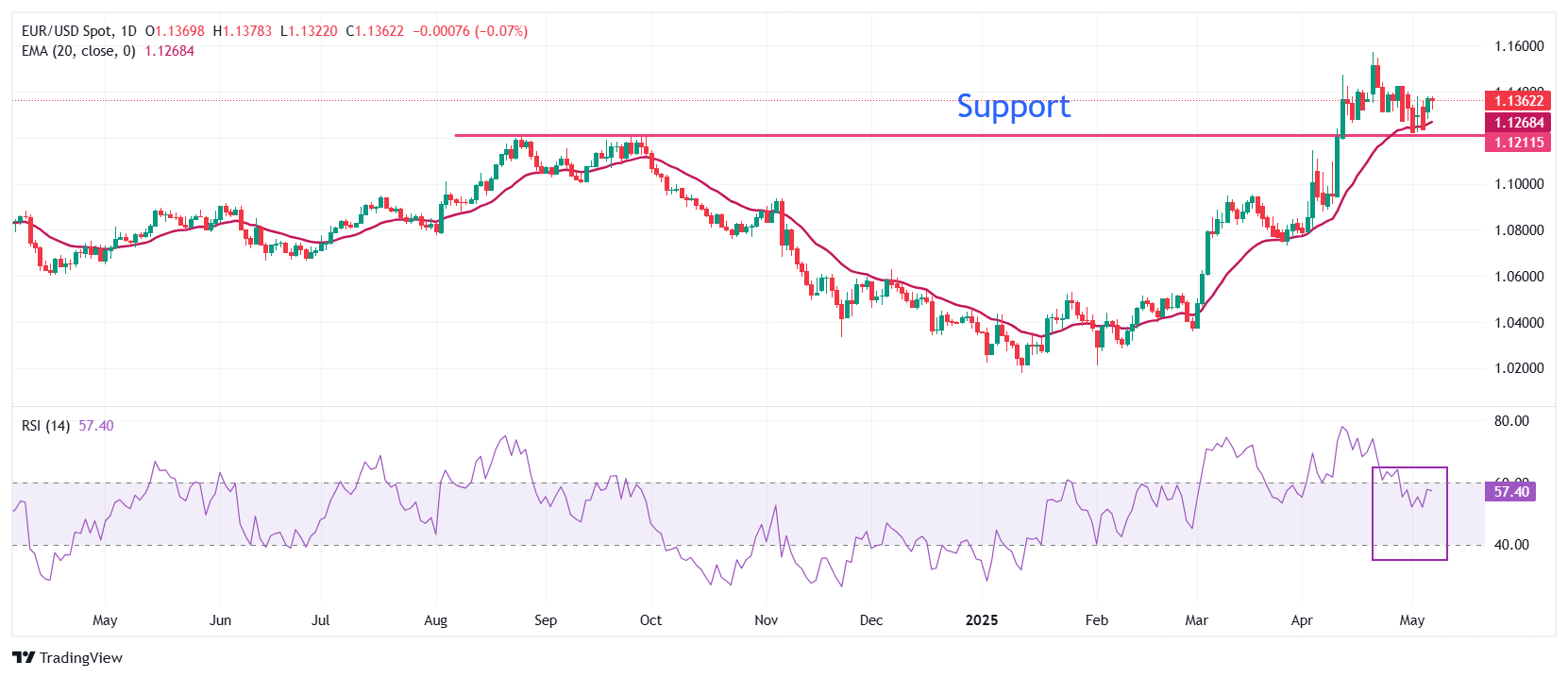-
EUR/USD dips to around 1.1350 as the US Dollar gains slightly ahead of the Fed’s monetary policy decision.
-
Investors will focus on the Fed’s guidance regarding its future monetary policy.
-
Conservative leader Merz was sworn in as German Chancellor in his second attempt.
EUR/USD dips to around 1.1350 during European trading hours on Wednesday, as the US Dollar edges higher ahead of the Federal Reserve’s (Fed) interest rate decision at 18:00 GMT. The US Dollar Index (DXY), which measures the Greenback against six major currencies, rises to nearly 99.55.
According to the CME FedWatch tool, traders have fully priced in a decision to keep interest rates unchanged in the current range of 4.25%-4.50%. Investors will closely monitor the monetary policy statement and Fed Chair Jerome Powell’s press conference for guidance on how long the Fed will maintain its restrictive stance.
Fed officials have suggested that no policy changes are likely until signs of weakness appear in the labor market or economic growth, with consumer inflation expectations rising due to the impact of new economic policies from US President Donald Trump.
April’s Nonfarm Payrolls (NFP) data showed steady job growth, which limits the Fed’s ability to cut rates. Meanwhile, the US economy contracted by 0.3% in the first quarter, driven by a significant surge in imports as businesses tried to avoid the impact of higher tariffs.
In contrast to the Fed’s stance, President Trump has repeatedly called for rate cuts and even threatened to remove Jerome Powell from his position over the central bank’s refusal to reduce borrowing costs, despite falling energy and food prices.
In addition to the Fed’s policy decision, US-China trade talks in Geneva are a key focus for the US Dollar. US Treasury Secretary Scott Bessent and Trade Representative Jamieson Greer confirmed that they will meet their Chinese counterparts for trade discussions, which is seen as a positive step toward easing tensions in the Sino-US trade war, supporting S&P 500 futures.
Daily Digest Market Movers: EUR/USD Faces Pressure While Euro Remains Firm
- EUR/USD holds strength as the Euro (EUR) trades firmly following the confirmation of Conservative leader Friedrich Merz as Germany’s Chancellor on his second attempt. In his first attempt, Merz failed to secure an absolute majority, garnering 310 votes out of the 316 needed. The confirmation has alleviated concerns about political instability in Germany and is expected to boost defense spending measures approved in March, strengthening the German economy and benefiting the Euro and German assets.
- However, the Euro’s upside potential appears limited as the European Central Bank (ECB) is likely to continue its accommodative stance, with an interest rate cut expected in the upcoming June meeting. ECB officials are prioritizing measures to absorb economic shocks from tariffs imposed by US President Trump, rather than focusing on inflation, which is expected to return to the ECB’s 2% target by year-end.
- On the global stage, the European Union (EU) Commission is considering countermeasures against the impact of US tariffs. EU Trade Commissioner Maros Sefcovic noted that the EU is exploring responses while US President Trump has delayed reciprocal tariffs for 90 days. However, Sefcovic emphasized that resolving trade issues with the US remains the EU's top priority. According to a Bloomberg report, the EU may impose additional tariffs on approximately €100 billion worth of US goods if trade talks do not yield a satisfactory result.
- On the economic front, EU Retail Sales data for March came in weaker than expected, with a 0.1% month-over-month decline compared to the anticipated flat performance. February’s Retail Sales were revised down to a 0.2% increase from 0.3%. Year-on-year, Retail Sales grew by 1.5%, slower than the expected 1.6% and a decrease from the previous figure of 1.9%, which was revised down from 2.3%.
Technical Analysis: EUR/USD Holds Above 20-Day EMA

EUR/USD struggles near Tuesday's high of 1.1370 on Wednesday, but the overall outlook remains bullish as the pair stays above the 20-day Exponential Moving Average (EMA) around 1.1270.
The 14-day Relative Strength Index (RSI) sits within the 40.00-60.00 range, suggesting that the recent bullish momentum has paused. However, the upward bias remains intact.
To the upside, the psychological level of 1.1500 serves as the key resistance for the pair. On the downside, the 25 September high at 1.1214 will be an important support level for Euro bulls.





